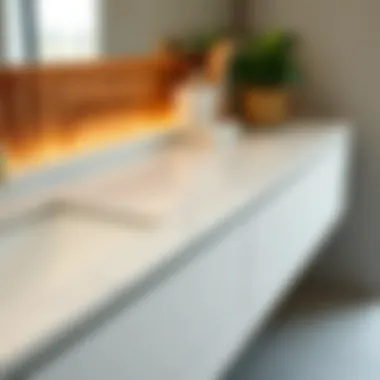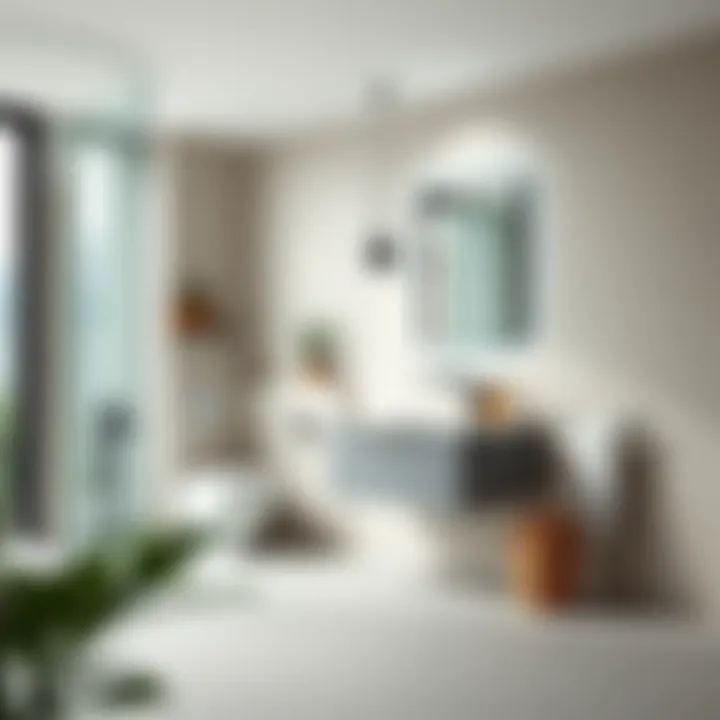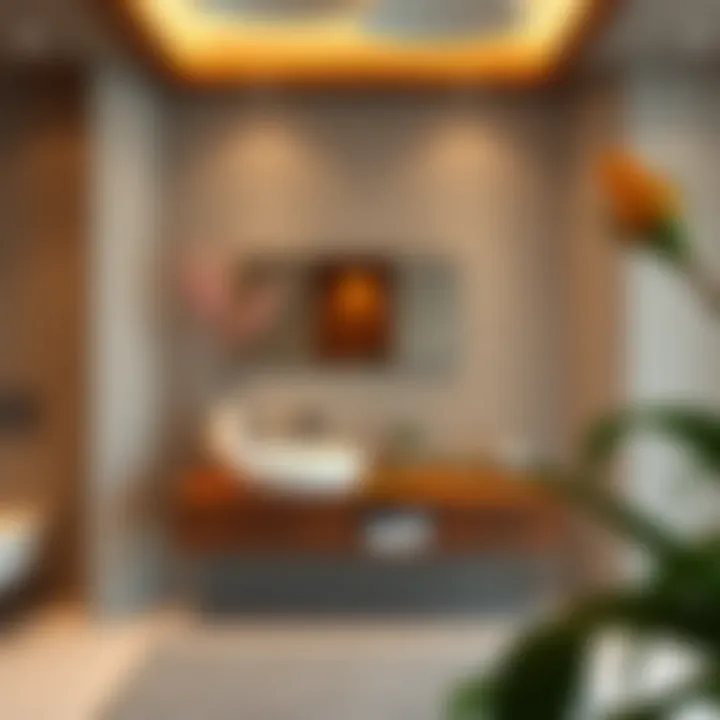The Ultimate Guide to 19 Inch Floating Vanities


Intro
In the realm of modern bathroom design, the allure of floating vanities has garnered significant attention. Specifically, the 19 inch floating vanity strikes a balance between form and function, boasting not only an aesthetically pleasing profile but also practical advantages. With an increasing trend amongst homeowners and interior designers alike, this guide sets out to explore every facet of these clever fixtures.
Let's face it: bathrooms are often the unsung heroes of our home. These spaces deserve a thoughtful touch, and the right vanity can transform them from mundane to magnificent. Whether you’re tackling a full renovation or just a quick refresh, understanding what a 19 inch floating vanity offers can help steer your decisions.
In this article, we’ll wander through the intricate details of these vanities—covering design inspiration, practical advice, and more. This isn’t just a rundown of styles; we aim to provide you with insights on materials, colors, as well as installation and maintenance tips. Homeowners, designers, and DIY enthusiasts will find tailored guidance on selecting a vanity that harmonizes with their vision, ensuring both functionality and beauty.
So, roll up your sleeves and prepare to dive into the world of 19 inch floating vanities. A space that might have gone unnoticed can be your next design triumph.
Intro to Floating Vanities
The bathroom is often viewed as a sanctuary within the home, a place for relaxation and personal care. Elements we choose for this space, especially the vanity, play a critical role in defining both its function and aesthetic appeal. Floating vanities, in particular, have surged in popularity due to their blend of style and practicality.
Floating vanities are wall-mounted fixtures that do not reach the floor. This distinctive design not only provides a modern look but also enhances the sense of space, making bathrooms feel larger than they are. Comprehending the significance of these vanities will aid homeowners and designers in making informed decisions that harmonize with their overall design goals.
Defining Floating Vanities
At their core, floating vanities are characterized by their lack of undue bulk. They hover above the ground, allowing for unobstructed floor space beneath them. This design creates a feeling of airiness, which is particularly beneficial in smaller bathrooms. Floating vanities come in a variety of sizes, styles, and materials. Most importantly, they create a sleek appearance while maximizing functionality.
The crucial aspect of these vanities is their customizable nature. Depending on individual needs, one can go for a single or double sink option, and choose from an array of finishes—such as wood, laminate, or composite materials. With thoughtful selection, a floating vanity can mirror the personality of the owner, incorporating elegant, rustic, or even minimalist styles to match the surrounding decor.
Evolution of Bathroom Vanities
A look back at the evolution of bathroom vanities reveals their transformation from bulky, traditional designs to the sleek, sophisticated models we see today. Traditionally, a bathroom vanity was a large, stationary piece of furniture, often made from heavy hardwoods. These designs tended to overshadow the bathroom space rather than complement it. However, as design sensibilities evolved over the years, so too did the functionality expected from bathroom fixtures.
Over time, homeowners began to favor accessible, easy-to-clean solutions over heavy ornate furniture. This shift led to the popularity of floating vanities, as they cater to the modern consumer's demand for both style and utility. They not only save floor space but also make cleaning a breeze—no more dust bunnies lurking under hefty cabinets.
Additionally, contemporary designs consider sustainability and smart technologies, infusing innovations such as energy-efficient lighting and eco-friendly materials. Today’s floating vanities reflect the culmination of these trends, merging visual appeal with practical needs. In doing so, they symbolize the modern approach to interior design that prioritizes functionality without compromising elegance.
Exploring the Inch Measurement
When it comes to bathroom design, size matters—especially when selecting floating vanities. The 19-inch measurement is a goldmine for both functionality and aesthetics. This dimension strikes a balance, catering to smaller bathrooms while providing ample storage and style. This section unveils not just the standard dimensions commonly used, but also illustrates why this size has gained such popularity in modern homes.
Standard Dimensions and Their Significance
Floating vanities generally come in a variety of widths, ranging from compact sizes like 24 inches down to 19 inches. The 19-inch vanity has unique significance specifically because it efficiently serves a dual purpose.
- Practical Size: In smaller bathrooms or powder rooms, where every inch counts, a 19-inch floating vanity fits like a glove. It offers functionality without overwhelming the space.
- Design Harmony: The proportion of a 19-inch vanity complements various designs, from contemporary to traditional. It allows homeowners to create a cohesive look without sacrificing utility.
- Space Utilization: This size can be paired effectively with other elements like mirrors and light fixtures, emphasizing vertical spaces instead of cluttering the area horizontally.
In summary, the standard dimensions of a 19-inch floating vanity speak directly to the needs of many homeowners facing the challenge of limited bathroom space. This measurement holds an important place in bathroom design discussions as it meets both aesthetic and practical needs.
Benefits of Smaller Vanity Sizes
Choosing a smaller floating vanity size, such as the 19-inch option, brings about several practical and aesthetic benefits:
- Easier Access: Smaller vanities occupy less visual and physical space. This accessibility can make for a more open and inviting bathroom feel, which is crucial in areas lacking room.
- Cost-Effective Choices: Floating vanities tend to vary in price, and smaller sizes like the 19-inch models often come with a more attractive price point, making them an economical choice for renovations or new builds.
- Stylish Displays: A 19-inch vanity allows room for decorative elements like greenery or unique toiletries that add personal style. It creates a chance to curate an appealing, organized setup without overcrowding.
- Flexibility in Layout: With this size, homeowners have opportunities for creative layouts, devising spaces that maximize usability without compromising style.
When considering the 19-inch measurement, it’s crucial not just to focus on size but also to acknowledge how these dimensions can transform a space, shaping it to fit the needs and tastes of individuals.
Design Considerations for Inch Floating Vanities
When it comes to selecting a floating vanity, the design considerations are paramount; they can greatly influence the overall feel and functionality of a bathroom. Choosing the right design elements not only enhances aesthetics but also ensures that the space remains practical and user-friendly. Let's break this down into key aspects that every homeowner and designer should keep in mind.
Integrating Style with Functionality
In the world of interior design, where style meets functionality, floating vanities definitely stand out. They are not merely about good looks; they also serve a practical purpose. With the 19 inch size, these vanities provide an opportunity to create a streamlined appearance while maximizing floor space. When considering style, one might think about the bathroom's overall theme. Is it modern, rustic, or perhaps eclectic? It’s vital that the vanity compliments the existing fixtures, enhancing visual harmony.
Consider incorporating sleek lines and minimalistic designs if the space is contemporary. Materials like quartz or glass can evoke a sense of luxury while being durable. On the other hand, reclaimed wood can bring warmth and charm to a more traditional setting. The key here is to balance aesthetic appeal with utilitarian needs—ensuring that the chosen vanity not only looks good but also meets the everyday requirements of bathroom use.
Color Schemes and Textures


The choice of color schemes and textures can be a game changer when it comes to establishing the mood of the bathroom. For a 19 inch floating vanity, selecting the right colors can either enhance or detract from your design. Lighter colors, like soft whites or muted pastels, can make a small space feel larger and more open. In contrast, deeper hues like navy blue or forest green can create a dramatic effect but could potentially make the area feel more closed-in if not paired correctly with surrounding elements.
Textures play a crucial role too. Mixing materials, like pairing a smooth countertop with a textured wood or tile, can add depth and interest. A matte finish on a vanity can lend a contemporary edge, while a glossy surface might evoke a more classic touch. Remember, the right combination of color and texture can lead to an inviting ambiance.
Choosing the Right Hardware
The hardware selected for your floating vanity often gets overlooked but can play a major part in the overall impression of your space. Handles, knobs, and faucets should harmoniously tie together the vanity's concept. Choosing the right finish for your hardware—whether it's brushed nickel, polished chrome, or aged bronze—can perfectly accentuate the design theme you’re shooting for.
Additionally, the scale of the hardware matters as well. For instance, oversized hardware works beautifully on larger vanities but can overwhelm a compact 19 inch vanity, leading to an imbalance in the visual presentation. A trick is to opt for sleek, streamlined fixtures that don’t overpower the cabinetry but still provide enough functionality.
"The right hardware doesn’t just hold things together—it pulls your entire bathroom from ‘meh’ to ‘wow’.”
By focusing on these details, homeowners and designers alike can ensure that their bathroom remains functional and stylish, embodying the essence of modern designs.
Materials Used in Construction
When it comes to selecting a 19 inch floating vanity, the materials used in construction significantly influence both the overall appearance and functionality of the piece. Different materials offer unique benefits, and understanding these can steer homeowners and designers towards making more informed choices, thereby enhancing design integrity and user satisfaction.
Popular Materials for Floating Vanities
Choosing the right material for a floating vanity can be the difference between a stunning focal piece and a source of frustration. Several materials stand out in the market, each with its strengths and weaknesses:
- Plywood: Often lauded for its durability and resistance to warping, plywood can handle the humidity often found in bathrooms. It's light yet sturdy, making it ideal for wall-mounted designs.
- Solid Wood: Rich in warmth and character, solid wood brings a classic touch to any bathroom. However, caution must be taken as it can be susceptible to moisture if not properly sealed.
- MDF (Medium Density Fiberboard): Applied with a veneer or laminate, MDF is a cost-effective choice that provides a smooth finish. It’s easier to work with and highly versatile, but it does not fare well in high-moisture environments unless treated.
- Metal: For those inclined towards a contemporary look, metals like stainless steel or brass offer a sleek, modern aesthetic. They are easy to clean and incredibly durable.
- Glass: Often used for countertops or accents, glass can add elegance and an expansive feel to smaller spaces. However, this material requires regular cleaning to maintain its clear finish.
Each of these materials behaves differently under stress, wear, and moisture, affecting not just aesthetics but function and lifespan.
Durability vs. Aesthetics
When it comes to floating vanities, the age-old debate of durability versus aesthetics comes into play. Many might find themselves fascinated by the allure of visually striking options, yet it's paramount to consider longevity. A beautiful vanity that buckles under the pressure of everyday use isn’t a savvy investment.
Durability is key in bathroom furnishings, as exposure to water and heat can wreak havoc on lesser materials. Here’s how you can weigh your options:
- Material Longevity: Solid wood may offer a timeless aesthetic but expect to invest in maintenance. Materials like plywood and certain metals could bear the brunt of adverse conditions without flinching.
- Design Integrity: You don’t need to sacrifice style to achieve durability. Innovative coatings now allow for materials that once wouldn't hold up against moisture to be both eye-catching and resilient.
An ideal choice strikes a balance, marrying beauty with practical longevity. As the old saying goes, "you get what you pay for," rings especially true in this arena. Choosing wisely will not only enhance the bathroom's visual appeal but also its functionality over time,
"Investing in quality materials can save you a headache down the line."
Understanding the interplay between aesthetics and durability can act as a guiding compass, steering decisions toward a floating vanity that resonates for years to come.
Installation Process
The installation of 19-inch floating vanities can significantly affect both their functionality and aesthetic appeal in the bathroom. Proper installation is essential not just for visual aesthetics but also for safety and long-term durability. Misalignment or improper securing can lead not only to poor performance but can also pose risks like water damage or accidents. Therefore, understanding this process clearly sets homeowners and designers on the right path to achieving that elegant, airy feel floating vanities are known for.
Preparation Before Installation
Before diving into the actual installation of a 19-inch floating vanity, several preparation steps must be taken. Here’s what one should consider:
- Measuring the Space
Accurate measurements are crucial. Identify the height at which the vanity will be installed, ensuring that it fits comfortably within your bathroom space. Remember to measure from the floor to the desired top of the vanity, taking into account the sink height. - Gather Necessary Tools
Having the right tools at hand can make the installation process smoother. Gather tools such as a level, drill, stud finder, measuring tape, and brackets for mounting. - Selecting the Location
Choose a location that works for plumbing and accessibility. Ensure that there’s enough space for doors and drawers to operate freely. - Planning for Plumbing
If not already adjusted, you may need to modify your plumbing setup. Ensure all pipes are accessible and in the right position. - Wall Inspection
Inspect the wall where the vanity will be mounted, checking for moisture or structural integrity. If there’s any damage, it should be addressed before proceeding.
Proper preparation is half the battle won.
By following these preparatory steps, you lay a foundation for a successful installation.
Step-by-Step Installation Guide
Once the preparations are complete, it’s time to get down to the installation. Here’s a simple yet effective step-by-step guide:
- Mark the Wall
Using a level and a pencil, mark where the top of the vanity will be placed. Create a clear and straight line around the area, which will help in aligning the unit correctly. - Locate Wall Studs
Use a stud finder to locate studs in the wall. Securing the vanity to the studs is crucial for stability. Mark these locations on the wall. - Install Brackets
Depending on the specific floating vanity, install the wall brackets according to the manufacturer’s instructions. Make sure they are precisely level and securely anchored into the studs. - Hang the Vanity
With assistance, lift the floating vanity and mount it onto the installed brackets. Ensure it’s level and firmly attached to the wall. - Secure Plumbing
Reconnect any plumbing that was detached during the process. Be careful and consider using new seals or fittings if necessary. - Final Adjustments
Make any final adjustments to ensure that the vanity aligns with your aesthetic expectations. This step can involve making sure all doors open correctly, are aligned, and adjusting small screws if necessary. - Cleanup
Remove any debris generated during installation and ensure that the area is clean and ready for use. - Final Check
Lastly, check the vanity for stability and ensure that everything is functioning correctly. It’s always better to catch any issues early on.
By following this guide, one can achieve a smooth installation process that elevates the function and design of the bathroom with the elegant touch of a 19-inch floating vanity. For further details and additional resources check out Wikipedia on Bathroom Design.
Maintenance and Care


The importance of maintenance and care for 19 inch floating vanities cannot be overstated. Without regular upkeep, the aesthetic charm and functional benefits these modern fixtures provide can quickly diminish. Floating vanities, while stylish, often expose plumbing and wall surfaces that require attention. Proper care not only extends the life of the vanity but also ensures that the bathroom remains a clean and inviting space. Homeowners and designers alike must embrace a robust maintenance routine to safeguard their investment and enhance their overall bathroom experience.
Regular Cleaning Practices
Cleaning should be an integral part of the routine when caring for floating vanities. Dust, soap residue, and water spots can accumulate, detracting from their visual appeal. Here are some best practices for regular cleaning:
- Use Soft Cloths: Microfiber cloths are excellent because they don’t scratch surfaces. Avoid abrasive materials that can cause damage.
- Mild Cleaners: Stick to pH-balanced cleaners or natural solutions like vinegar and water. Harsh chemicals can strip away finishes or discolor materials.
- Frequent Dusting: A quick dusting once a week can prevent buildup. Don’t forget to clean hidden spaces, such as beneath the vanity, where dust can easily collect.
- Spot Cleaning: Address spills immediately to prevent staining. A simple wipe-down with a damp cloth can do wonders.
- Regular Inspection: Check for signs of wear or damage. Early detection can save you from costly repairs down the line.
As you maintain your vanity, it is crucial to consider the specific materials used in its construction. Some surfaces require more delicate care than others. For example, woods may need periodic oiling to preserve their natural beauty, while glass surfaces could require a different cleaning approach.
Addressing Common Issues
Despite careful maintenance, various issues may arise with floating vanities. Here are some common problems and recommendations for tackling them:
- Water Damage: Even small leaks can lead to significant damage over time. If you notice discoloration or soft spots on the surface, identify the source and seal any leaks promptly.
- Loose Fixtures: Regularly check the sink and any attached hardware for looseness. Tighten screws or bolts as necessary to avoid accidents.
- Staining: In the event of stains, address them with appropriate cleaning agents specific to the material. For instance, while wood may respond well to baking soda pastes, glass often requires specific glass-cleaning solutions.
- Fading Colors: Exposure to sunlight can fade colors over time. Consider positioning to minimize direct sun exposure or using window treatments that block UV rays.
- Odors or Mold: Musty smells or visible mold growth can occur in damp environments. Ensure proper ventilation and consider utilizing dehumidifiers if humidity levels are too high.
Pro Tip: A predisposition toward preventive measures, like proper ventilation and immediate cleanup of spills, is the best defense against many common issues.
By incorporating these maintenance practices and being proactive in addressing potential problems, you can preserve the elegance and functionality of your 19 inch floating vanity for years to come. A little care goes a long way in ensuring that your bathroom remains not just a necessity, but a sanctuary.
The Role of Floating Vanities in Bathroom Design
In the realm of contemporary bathroom design, floating vanities have carved out a niche that goes beyond mere aesthetics. They have become a fundamental element, shaping not just the look, but also the feel, of the space. Floating vanities are not only functional, but they also serve as a focal point that can elevate the entire bathroom design. From sleek modern looks to rustic charm, the adaptability of these vanities marks their importance in various design narratives.
One primary benefit of a floating vanity is how it creates an illusion of space. In smaller bathrooms, the typical footprint often feels crammed. But a floating model, by leaving floor space visible, tricks the eye and can make the area feel larger than it is. The visual lightness offered by such designs is particularly valued in urban homes where every square inch counts.
Creating a Modern Bathroom Space
In modern baths, simplicity meets sophisticated form. A floating vanity embodies this ethos perfectly, often featuring clean lines and a minimalistic approach. Think about a space with a bold statement color as a backdrop, while the vanity itself is done in a sleek white or light wood finish—these contrasts not only pull the eye but maintain a fresh ambiance.
Here are a few pointers to consider when incorporating floating vanities into a modern bathroom:
- Sleek Hardware: Opt for simple handles or integrated pulls that complement the vanity’s demeanor.
- Integrated Lighting: Employ LED strips or wall sconces that add a touch of modern flair while also illuminating the workspace effectively.
- Natural Materials: Use stone, wood, or quartz for countertops, balancing the modern aesthetic with warmth.
Enhancing Spatial Perception
Floating vanities not only serve a functional purpose by providing essential bathroom storage, but they can also enhance how your space is perceived. When a bathroom feels spacious, it tends to promote a calming atmosphere, and this can often be achieved through clever design elements like a floating vanity. When these vanities are mounted higher on the wall, it allows the floor to be visually uninterrupted. This continuous line gives a sense of expansion—not limited by the base of traditional furnishings.
- Color Consistency: Keeping the color of the vanity similar to that of the walls can strengthen the illusion of a larger space.
- Mirrored Surfaces: Utilizing reflective materials like mirrored finishes can further enhance the open feel, particularly in compact rooms.
"A well-designed floating vanity doesn't just serve as a fixture; it becomes a design statement that invites functionality and spatial elegance into the bathroom."
In summary, floating vanities hold significant potential in redefining the bathroom's layout and overall aesthetic. Their strategic placement and stylish design contribute greatly to a modern flair, while also manipulating spatial perception, making them an invaluable asset in today’s bathroom designs.
Comparative Analysis with Traditional Vanities
When it comes to bathroom design choices, the juxtaposition of 19 inch floating vanities and traditional vanities is a crucial topic to explore. While both offer solutions for storage and style, their characteristics differ significantly. By dissecting these differences, one gains a clearer understanding of the practical benefits that floating vanities provide while shining a light on their unique offerings in modern home design.
Weight and Space Considerations
The first, and perhaps most noticeable, difference lies in weight and space. Floating vanities, as the name suggests, are mounted to the wall and do not rest on the floor like traditional vanities. This design choice opens up the floor space, creating an illusion of wider areas. For homeowners in smaller bathrooms, this can feel like a breath of fresh air.
- Lightweight Design: Floating vanities are often constructed from lighter materials compared to traditional counterparts. This doesn't just make installation simpler—it also alleviates worries regarding potential strain on wall support systems. Moreover, lighter fixtures can sometimes allow for more creative installation options.
- Space Efficiency: In a world where maximizing space is key, floating vanities offer a leg up. They allow for unobstructed cleaning beneath the unit, aiding in maintaining hygiene, and enhancing the overall aesthetic. In contrast, traditional models can crowd small spaces, making it tricky to navigate in tighter quarters.
"A floating vanity can create the illusion of more space in a room; it’s like giving your bathroom a little more room to breathe."
Style Versatility
Another significant area of distinction is style versatility. Floating vanities provide a modern aesthetic that can cater to various design tastes and preferences, proving themselves adaptable across multiple styles—from contemporary to minimalist.
- Adaptable Design: The clean lines and elegant proportions of floating vanities complement a wide variety of design motifs. Whether you prefer a sleek, modern setup or something more rustic, there’s likely a floating vanity that suits your vision. They can be customized with various colors, finishes, and materials to match the existing bathroom decor or to serve as a stunning focal point.
- Contrasting Styles: Traditional vanities often come with a classic frame, which may limit options when attempting to blend different styles. Floating vanities, however, can emphasize a room's openness and provide that perfect contrast to more ornate designs. Homeowners can exploit this flexible nature by mixing floating units with accent pieces, such as vintage mirrors or traditional lighting.


Moreover, floating vanities can include integrated features like shelving or built-in sinks while still maintaining an airy feel that most traditional designs simply can’t touch.
Cost Consideration and Value
When it comes to transforming a bathroom, the expenses associated with fixtures can quickly pile up. Floating vanities, especially the 19-inch varieties, represent a unique juxtaposition of style and practicality. In this section, we will delve into the integral aspects of cost, illuminating why understanding this facet is pivotal for homeowners, designers, and decorators alike.
The cost of bathroom renovations can vary tremendously depending on the choices made. Floating vanities can often present a higher initial price point compared to traditional styles. However, it’s not merely about the upfront investment—understanding cost considerations imbues buyers with insight into long-term value. For instance, let's discuss a few essential components.
- Quality of Materials: The substance from which a floating vanity is crafted significantly impacts its price. Materials like solid wood or high-grade plywood generally incur higher costs but offer better durability. Conversely, options like medium-density fiberboard or particleboard may be less expensive but can lead to higher replacement costs over time due to wear and tear.
- Design Complexity: Custom designs or intricate styles with unique hardware options can escalate costs. Each customization increases the price, but it may yield a product that aligns more perfectly with the homeowner’s vision, thus enhancing the overall aesthetic appeal of the bathroom.
- Installation Fees: Don’t forget to factor in potential installation costs. While some may feel confident in a DIY approach, enlisting professional help can yield more precise results but at a premium.
- Additional Features: Many floating vanities now come equipped with added functionalities, like integrated lighting or smart technology modules. While these features may bump up the initial cost, they can also lead to enhanced user experience, making them potentially worth the investment.
"Understanding the full scope of costs related to floating vanities can steer a homeowner's decision-making toward a more informed and ultimately satisfying purchase."
Navigating these factors ultimately allows individuals to align their budget with their design aspirations, ensuring that the money spent matches the value gained.
Budget Ranges for Floating Vanities
The market for 19-inch floating vanities exhibits a diverse range of pricing options tailored to fit various budgets. Typically, you can find vanities starting around $150 for more basic models, moving up to $400 or even higher for premium selections.
- Entry-Level Vanities: These are basic models often made from less expensive materials. Ideal for budget-conscious homeowners, they can still offer a stylish touch without breaking the bank.
- Mid-Range Selections: Priced between $400 to $800, these vanities usually feature superior craftsmanship, better materials, and some degree of customization. They serve the perfect middle ground for those seeking both style and value.
- High-End Options: For those willing to invest more, prices can exceed $800. These models often come with exquisite design, luxury materials, customizable features, and heightened durability, making them a worthwhile long-term investment.
Evaluating Return on Investment
Assessing the return on investment (ROI) for a 19-inch floating vanity is crucial for gauging its worth in a homeowner's budget. A well-chosen vanity can enhance not only the aesthetics of a space but also its overall value.
- Home Resale Value: Investing in quality floating vanities is often viewed favorably in terms of resale. Potential buyers frequently prioritize modern, stylish bathrooms, and a well-chosen vanity can significantly elevate perceived home value.
- Durability and Longevity: The ROI is also tied to the usable lifespan of the vanity. Spending a bit more on high-quality materials can mean fewer replacements over the years, thus saving money in the long run.
- Energy Efficiency: Many modern floating vanities integrate energy-efficient lighting or innovative plumbing solutions. These features can translate to lower utility bills, enhancing the value proposition over time.
By weighing these factors alongside the initial expenditure, homeowners can make informed decisions that help create a fulfilling, practical, and valuable bathroom space.
Future Trends in Bathroom Vanities
As we look ahead in bathroom design, understanding the future trends in bathroom vanities becomes vital for anyone looking to upgrade their space. This evolving landscape highlights not just aesthetic changes but also the innovative technologies and sustainable practices that influence how these essential fixtures are both designed and utilized.
Emerging Materials and Technologies
The choice of materials significantly shapes the character and durability of bathroom vanities. Gone are the days when wood or particleboard dominated the scene. Nowadays, we see a diverse array of materials making their entrance into the market. For instance, quartz and granite are becoming favorites, thanks to their resistance to stains and scratches while still delivering a sleek, high-end appearance.
New materials like recycled glass or bamboo are also gaining traction, appealing to the eco-conscious consumer. These choices aren’t just about aesthetics; they enhance the overall sturdiness of the vanity while lessening the environmental impact—really a win-win!
Innovations in technology are another exciting front. Smart vanities equipped with touchless faucets, integrated lighting, or heated surfaces are steadily claiming a sound spot in consumers’ hearts. For example, mirror vanities that can adjust brightness or display the weather can simplify the daily routines. The integration of technology not only boosts convenience but also adds a layer of luxury that many homeowners are looking for in modern interiors.
"As technology and eco-consciousness advance, the bathroom could transform into one of the most innovative spaces in the home."
Sustainability in Furniture Design
Sustainability has become more than just a buzzword; it's a guiding principle in design today. From production methods to the materials used, sustainability in furniture design is at the forefront of buyers' minds. Manufacturers are increasingly prioritizing environmentally friendly processes. This includes the use of sustainable woods sourced responsibly, low-VOC paints, and finishes, and options that help conserve energy and water.
Consumers are seeking not just stylish but also eco-friendly solutions that contribute to a smaller carbon footprint.
Benefits of sustainable practices include:
- Reduced Waste: Companies are jazzing up their production methods to minimize waste, resulting in a more responsible manufacturing cycle.
- Longevity: By prioritizing durable materials, sustainable vanities offer better longevity, ultimately leading to better cost efficiency over time.
- Health Benefits: Using low-emission materials leads to healthier indoor air quality, ensuring a safer environment for families.
As we move forward, it’s clear that the bathroom vanity will not remain static; it’s poised for transformation, influenced by advances in technology, a diversified material palette, and an unwavering commitment to sustainability. This fruitful amalgamation points towards a future decorated with beauty and responsibility.
The End
In bringing together various threads of information, the conclusion serves as a pivotal element within this article. It encapsulates the essence of 19 inch floating vanities, tying together the discussion about their unique qualities, practical benefits, and aesthetic versatility. Floating vanities have gained popularity not just for their modern appearance but also for their functionality in optimizing space in bathrooms.
Summary of Key Points
- Defining Characteristics: Floating vanities, distinct for their wall-mounted design, create an illusion of more space, making bathrooms feel larger.
- Design Flexibility: They seamlessly blend with diverse decor styles, from minimalist to extravagant, allowing homeowners to express their individual tastes.
- Installation and Maintenance: While installation requires some skill, the overall upkeep is quite manageable, with only basic cleaning needed to keep these vanities looking their best.
- Material Choices: The variety of materials available—from wood to glass—enables a range of looks while meeting different durability needs.
- Market Trends: Increased interest in sustainability has led to green materials and technologies that are becoming more prevalent in the production of floating vanities.
Final Thoughts on Inch Floating Vanities
The lasting appeal of 19 inch floating vanities lies in their ability to adapt to modern lifestyles. They are not just fixtures in a bathroom; they are key components that enhance overall design and functionality. As you consider the redesign or construction of your own space, the insights shared throughout this article can guide you towards making informed choices.
Whether you are drawn to sleek lines or prefer something more bold and artistic, the possibilities are vast. As you embark on your bathroom project, remember that a well-chosen 19 inch floating vanity can provide both aesthetic pleasure and practical utility, transforming an ordinary space into something special.
As bathroom trends continue to evolve, those investing in thoughtful design choices can look forward to not only enhancing their personal spaces but also adding substantial value to their homes.



